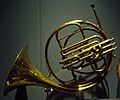Hunting horn facts for kids
The hunting horn is a special musical instrument. It's different from many other brass instruments because it doesn't have any keys or valves. This means musicians have to use their lips, cheeks, tongue, and breath to make all the sounds.
Sometimes, players even use their hand to block the sound inside the horn. This technique is called "Ton Bouché," which is French for "stopped sound." It helps create different tones and effects.
Contents
What is a Hunting Horn?
A hunting horn is a type of natural horn. This means it doesn't have valves or keys to change notes. Instead, players change the pitch by buzzing their lips and changing the air pressure. It's a bit like blowing into a bottle to make a sound.
How Hunting Horns Work
To play a hunting horn, musicians buzz their lips into a mouthpiece. This makes the air inside the long tube vibrate. By changing how fast the air vibrates, they can create different musical notes. It takes a lot of practice to control the sound perfectly.
Making Different Sounds
Since there are no keys, players use their breath and lip tension to get different notes. They can also use a technique called "hand-stopping." This is when a player puts their hand inside the bell (the wide end) of the horn. This changes the sound and can make new notes or special effects.
History of the Hunting Horn
Hunting horns have been used for hundreds of years. They were first used to communicate during hunts. Different calls could tell hunters where the animals were or signal danger.
The French Trompe d'Orléans
One famous type of hunting horn is the "Trompe d’Orléans." This French hunting horn was created around the year 1817. It is a natural horn, meaning it has no valves. It is usually tuned to the D major key. This horn can play notes across a range of three octaves. All musicians playing this horn use the same kind of instrument. Only the mouthpiece might be a little different for each player.
What Hunting Horns are Made Of
Hunting horns are usually made from a brass alloy. This is a mix of metals, often copper and zinc. Brass is strong but also flexible enough to be shaped into the horn's long, coiled tube.
Size and Weight
A typical hunting horn is quite light, weighing only about 750 grams. That's less than a kilogram! Even though it's light, the tube of the horn is very long. If you uncoiled it, the tube would stretch out to about 4.54 metres. That's longer than a car!
Images for kids
-
Cornicen (horn players) from Trajan's Column
-
Playing horn at Palace Temple. Mandi, Himachal Pradesh, India




















